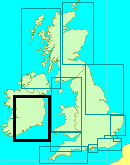You are viewing the expanded version of this Harbour,
for faster browsing
use the regular version here
Toehead Bay, Tragumna Bay and Barloge Creek
Courtesy Flag
Irish TricolourWaypoint
None GivenCharts
AC 2129 Long Island Bay to Castlehaven; SC5623.11 Crookhaven to Long Island & Cape Clear; Imray C56 Cork Harbour to Dingle BayRules & Regulations
Lough Hyne is a marine nature reserve set up by statute and, as such, has a raft of regulations on conduct within its bounds. Basically, there is a speed limit of 5kts, no water sports such as water skiing or diving without permission, no removal of anything living or dead without permission (that includes plant life), no dumping of rubbish and no defacing of any surface.Hazards
The entrance to Lough Hyne is impassable due to depth at the entrance. Bullock Island has rocks lying off its SW side which narrow the entrance to Barloge CreekTidal Data Times & Range
There is no tidal information for this bit of coast but the HW times of Baltimore and Castletownshend only differ by two minutes on most days and the depths vary by about two inches at most so for working purposes use Baltimore tide constants. HW Baltimore is HW Cobh – 0015; MHWS 3.5m MHWN 2.9m MLWN 1.4m MLWS 0.6mThis site is designed for slower, roaming broadband connections, like you would get at sea, so it needs JavaScript enabled to expand the text.
General Description
Toehead Bay and Tragumna Bay, five miles to the East of Baltimore, are exposed anchorages which will provide shelter
...... for a temporary stop (overnight) in winds from the North and East; there are no hazards and the best shelter, especially if you are in shallow draft boat, is the little bay at the West side of Tragumna Bay. If you can take the ground you can sneak in here and tip toe up to the virtually deserted beach and be quite snug. Be careful though because in any developed swell from the South this bay will turn into a maelstrom as will all three of these anchorages.
Barloge Creek is a popular spot for visitors because it is at the entrance to Lough Hyne which is a unique eco-system totally enclose apart from the narrow channel which feeds it sea water at the top of each tide. This lough is much studied, the diving is closely regulated to avoid over intrusion into the system and any activity which could be construed as harmful is prohibited. Entrance is over the sill in the “Rapids” where the current builds to five knots in either direction without any slack water at the change; one minute it’s flooding in and five minutes later it is ebbing out. Because it is so shallow, unless you choose to enter in the last couple of hours of the flood and exit during the first two hours of the ebb you will have to get out of your dinghy and push!! (One commentator complains of having to “portage” their Zodiac)
All that apart, the reason you will have made the effort to find and anchor in Barloge creek will be for the express purpose of visiting this lough and it very much worth doing so.
As has been said, in onshore conditions this becomes a dangerous lee shore with the force of the Atlantic behind any So’westerly so have a good look at the forecast before deciding to stop here. From photographic evidence this looks an idyllic suntrap but you must remember that nobody goes there to take holiday snaps in bad weather! The safety of Baltimore is only five miles West and a far better bet in bad weather.
Approach
The main problem about the approach is actually identifying the bit of coast
....... you are aiming for because, until you are quite close it all blurs together. It’s not a major problem coming up the coast from Baltimore as you can just wander up the coast quite close in until you reach Carrigathorna and turn in round that; watch out for the off lying rock to the south west of Sheelagh Bay and there’s another close in just south of Carrigathorna itself.
Coming in from the east, once you have weathered Gokane Point if you shape your course around 305 T (variation is 3°W for 2022) you should soon be able to pick out the entrance but be careful as the little stretch of coast between Drishane Point and Carrigathorna is peppered with small coves and islets; you want the one to the West of Bullock Island and you want the West side of that!! Mind you, having said that, there's a wee cove to the East of Bullock Island called Tranabo which deserves exploring and has a small pier and slip at its head.For a first visit it would probably be best to hand the sails and proceed in under motor.
Berthing, Mooring & Anchoring
As has been said, both Toehead bay and Tragumna Bay are exposed
...... to the South and South West and the best shelter is up against Tralispeen Beach on the West side of Tragumna bay.
In Barloge Creek anchor off the slip on the West side of the creek but don’t go too far in as it shoals quite rapidly. On spring tides you are unlikely to find enough depth for a fin keeler to anchor very close in on the west side of the creek but there is sufficient water close west of Bullock Island after you’ve cleared the outcrop of rocks on its SW side.
Facilities
There are no facilities ashore. The nearest village is Skibbereen over four miles away. Having said that there is a public house at the head of Tragumna Bay called the Skibbereen Eagle so, in calm weather that would be do-able.
Eating, Drinking & Entertainment
There are no supplies ashore.
Links
|
Your Ratings & Comments







